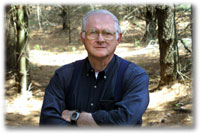A tree is a tree, is a
tree. Yes, but let’s also consider that
trees have personalities like so many other living creatures. And thus they may all be trees, but they are also
different from one another.
Take the white pine,
the tree that graced the northern regions of Wisconsin before the loggers
arrived. The white pine, with long soft
needles, five of them in a cluster, grows tall and makes a majestic statement
on a landscape. I have about five acres of them at Roshara, all self-seeded.
The red pine or Norway
pine as it is sometimes called, with two long needles in a cluster, is less
graceful, but will grow many inches a year on the worst possible soil. I've
planted thousands of them on my farm. They
are not as graceful as the white pine but they, too make a statement.
The jack pine is scraggly with branches that
grow this way and that. It is the
toughest of the conifers that grow on my farm-- a survivor of frigid winters
and dry hot summers. I have considerable respect for this native tree.
The white oaks that
grow in my oak woodlot are tall and strong and powerful to look at it. Their
soft gray bark contrasts with the deep furrowed bark of the black oaks. Even in winter, when their leaves are down,
white oaks are a sight to behold offering a dominant presence in my woodlot.
Not to forget the burr
oak, sometimes spelled bur oak, in some ways the toughest of the oaks for they
will grow two-hundred years and more.
They command respect if nothing more than for their long lives.
I have a few trees that
are a nuisance and have interfering personalities. They want to take over Roshara and have an
attitude that suggests they are more important than their cousins. Black locust and box elder quickly come to
mind.
What fun it is, at
least for me, to think about all the different kinds of trees that grow at
Roshara and how they manage to live together and mostly get along with each other.
If we humans could do as well.
THE OLD TIMER SAYS: Get
a acquainted with a tree. You’ll be surprised
what you might learn.
LOOKING FOR INFORMATION
I am working on the history of the Civilian
Conservation Corps (CCC) in Wisconsin, which will be published as a book by the
Wisconsin Historical Society Press. The
CCC operated throughout the country from 1933 to 1942, and had a strong
presence in Wisconsin. CCC boys planted
trees, helped with soil conservation, improved state and national parks, fought
forest fires and much more.
I am looking for photos, letters, diaries, and
stories told by and about Wisconsin CCC members—the work they did, what they
did in their free time, how they related to the communities in which they
worked, and whatever else someone might have.
Many Wisconsin families were involved with the CCC and their story has
not been told.
If anyone has such information, please get in touch
with me at: jerryappsauthor@gmail.com
UPCOMING
EVENTS:
Thursday, January 29, 2015
7:00 p.m. Stoughton Opera House. A Farm
Winter.
Go to: http://stoughtonoperahouse.ticketforce.com/orderticketsarea.asp?p=86&a=1 for further information.
Wednesday, February 4, 6:30
p.m.. Mt. Horeb Library (The Quiet
Season and The Great Sand Fracas of Ames County.
Saturday, February 14, 2:30
p.m. Garden Expo Madison. Garden Wisdom
Tuesday, February 24, 7:00
p.m. River Falls Library, The Great Sand Fracas of Ames County
Purchase Jerry’s
DVDS and his Books from the Patterson Memorial Library in Wild Rose, Wisconsin
(a fund raiser for them):
The library now has available signed
copies of Jerry’s DVDs, Emmy Winner, A
Farm Winter with Jerry Apps and Jerry
Apps A Farm Story.
Also available are several of Jerry’s
signed books including The Quiet Season
(on which the DVD A Farm Winter is
based), as well as Rural Wit and Wisdom
and Old Farm, (which are related to
the DVD Jerry Apps a Farm Story). Also
available is Jerry’s new novel, The Great
Sand Fracas of Ames County.
Contact the library for prices and
special package deals.
Patterson Memorial Library
500
Division Street

1 comment:
Jerry,
The diseases ravage the majestic trees-the chestnut, the elm, the ash, never the poplar or box elder. It just isn't right.
Post a Comment